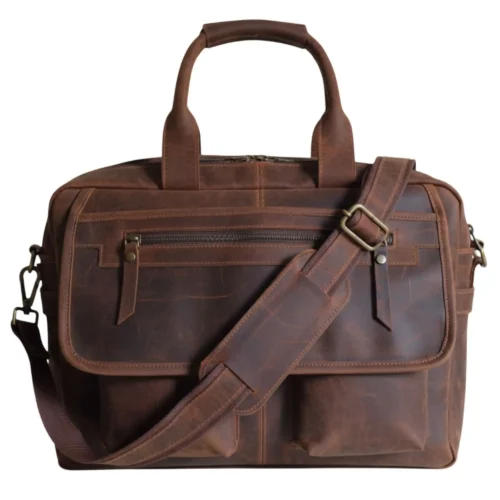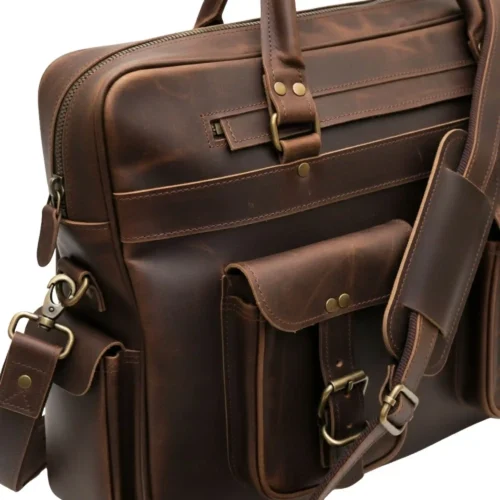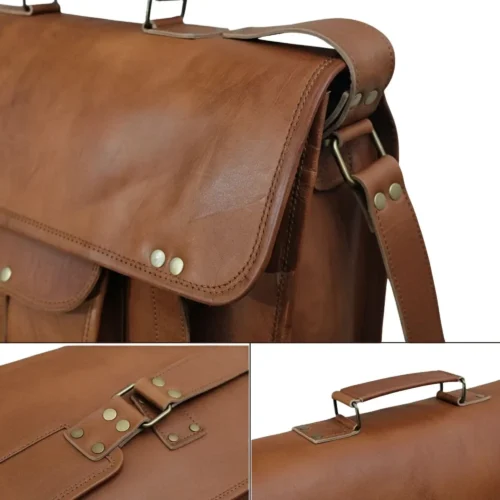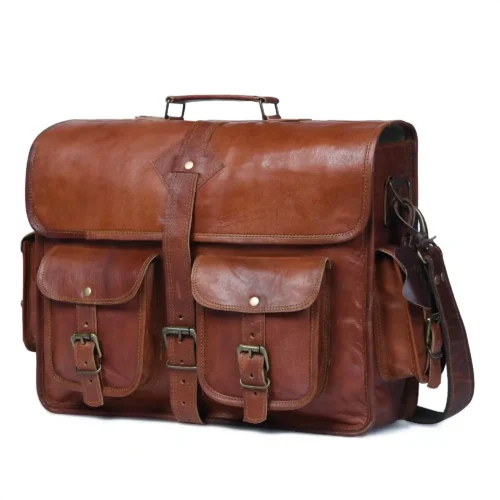
🚛 FREE SHIPPING | LIFETIME REPAIR WARRANTY | 20% Sale: “FREEDOM20”
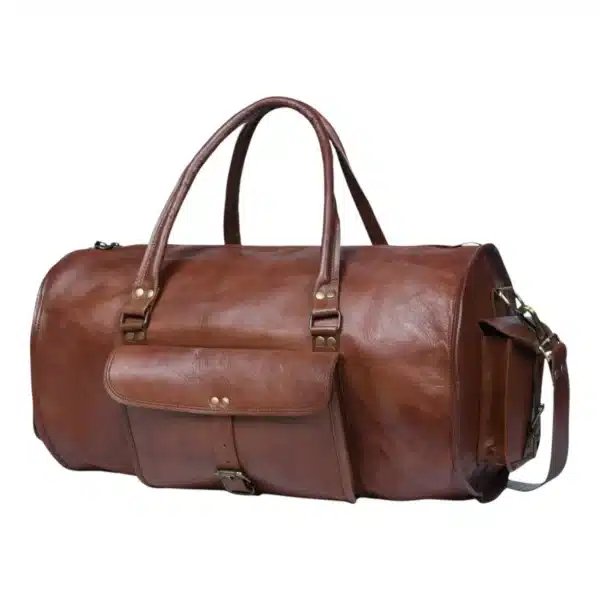
Leather tells a story- not just of craftsmanship and quality, but of endurance and evolution. Among materials used for bags, accessories, and apparel, genuine leather stands alone in how beautifully it ages. What starts as sleek and sturdy slowly transforms into something rich with character, depth, and history. This aging process, called patina, is what gives leather its unmistakable charm over time.
Before exploring why leather ages better than any other material, it’s essential to understand what genuine leather actually is. Genuine, high-quality leather,especially full-grain leather ,comes from the outermost layer of the hide. This layer maintains natural imperfections, pores, and texture that help it breathe and evolve over time.
Unlike synthetic leather, which is manufactured using plastic-based compounds, genuine leather retains organic properties that react to time, environment, and usage. This is precisely why the debate of genuine leather vs synthetic leather always tilts in favor of the real thing, authenticity brings longevity.
Synthetic materials may look flawless initially, but their perfection lacks depth. Over months and years, you’ll find synthetic options cracking, peeling, or fading. Genuine leather, on the other hand, develops character. It doesn’t wear out; it transforms.
Aging in leather is not decay, it’s development. Every fold, scratch, and touch adds more personality to the surface. This evolution is the visual and tactile magic behind how leather improves with time.
The natural oils inside the hide rise to the surface subtly, making the leather softer and more lustrous. Exposure to light darkens the pigment, adding richness to the tone. Touch and use polish the surface, giving that signature glow distinguished as a patina, especially on full-grain leather.
Patina is not just beauty; it’s authenticity. No two patinas ever look the same. This uniqueness is prized among true leather enthusiasts and collectors. A well-loved vintage leather duffle bag, for instance, carries the marks of every adventure, becoming a lifetime companion. Its grains, softened by years of handling, tell stories that synthetic counterparts can never replicate.
Patina on full-grain leather is often called the fingerprint of time. It’s an evolving layer of richness that forms as the leather interacts with its environment. Dust, sunlight, oils from your hands, and even humidity all contribute to this natural metamorphosis.
Full-grain leather is the highest quality classification in leather craftsmanship. It’s minimally processed, preserving the hide’s natural texture. Because of its tight fiber structure, it resists wear far more effectively than other materials. Instead of fading, it deepens in color; instead of weakening, it strengthens through conditioning and use.
On luxury goods such as vintage leather duffle bags or handcrafted wallets, the patina makes each item unique. A well-aged duffle bag doesn’t lose value,it gains it. Every mark is a part of its identity, cherished by artisans and owners alike.
Modern consumers increasingly recognize this beauty of imperfection. In a world saturated with fast fashion, patina becomes a symbol of authenticity and emotional value. Each scuff reflects a journey rather than a flaw.
One of the strongest reasons why leather lasts longer than other materials is its exceptional durability. Genuine leather is composed of tightly interwoven fibers that resist tearing and stretching. When paired with proper care and occasional conditioning, it can survive decades of daily use.
Consider durable leather products like boots, belts, and travel bags. They are designed not just to look elegant, but to perform under pressure. A full-grain leather duffle bag, for example, can handle weight, climate change, and continuous travel without losing shape. By contrast, materials like synthetic leather, nylon, or canvas may show premature fraying or dullness in a fraction of that time.
Leather’s resistance to deformation ensures your accessories retain form and utility. This durability makes genuine leather ideal for heirloom-quality goods, items you hand down through generations.
The comparison between genuine leather vs synthetic leather is both material and emotional.
| Feature | Genuine Leather | Synthetic Leather |
| Aging Process | Develops rich patina over time | Cracks and peels; no patina |
| Durability | Lasts for decades with care | Limited lifespan (3–5 years) |
| Texture | Warm, natural, and breathable | Smooth but artificial and non-breathable |
| Maintenance | Improves with conditioning | Deteriorates with wear |
| Environmental Impact | Biodegradable and sustainable when responsibly sourced | Non-biodegradable and petroleum-based |
| Aesthetic Value | Gains authenticity and prestige | Mimics appearance only temporarily |
What truly sets genuine leather apart is its ability to grow better with age. Instead of losing appeal, it gains personality. While synthetic options may work for short-term convenience, they fall short of creating a relationship with the owner.
A vintage leather duffle bag carried across years doesn’t just transport belongings, it carries memories. That emotional connection comes only with genuine leather, a living material that ages gracefully rather than deteriorating.
The aging of leather bags and accessories is a fascinating blend of chemistry and art. Every layer responds differently to climate and handling. The most common transformation stages include:
Luxury brands now emphasize this natural evolution as a selling point, not as deterioration, but as individuality. Saint Stag’s line of durable leather products, for instance, embodies this principle by crafting bags that only become more stunning as they age.
Every scratch or mark symbolizes growth, not wear. A full-grain leather duffle bag develops shades and nuances according to how you carry it. No two bags age the same way,making each piece uniquely yours.
The strength of leather lies in collagen fibers. When tanned using chromium or vegetable processes, these fibers interlock, forming a resilient network. This natural engineering gives leather remarkable resistance against pressure, moisture, and temperature fluctuation.
This structural advantage is why quality leather outperforms synthetic alternatives in durability and flexibility. Durable leather products like duffle bags, boots, and jackets are essentially investments.
While synthetic materials degrade because their polymer chains break down over time, natural leather builds flexibility through continued use. Aging doesn’t weaken it, it strengthens it. That is the scientific backbone behind why leather lasts longer than other materials.
Furthermore, genuine leather maintains breathability. Excess moisture escapes through its natural pores, preventing mold and odor. This makes leather a better long-term material for bags and accessories used daily.
There’s a growing trend among style enthusiasts to embrace vintage aesthetics, items that tell stories, not just fashion statements. A vintage leather duffle bag worn over years becomes more than an accessory. It becomes an extension of your identity.
From the subtle gloss developed through handling to the golden hue formed under sunlight, aged leather radiates warmth and personality. In photography, fashion shoots, or travel lifestyle branding, this vintage texture instantly conveys authenticity and adventure.
For brands like Saint Stag, promoting the timeless aesthetic of aging leather emphasizes sustainability and craftsmanship. Each bag is not just made; it’s crafted to evolve.
The benefits of full-grain leather go beyond beauty. It’s the strongest and most durable part of the hide because the grain layer remains intact. This layer protects the leather against moisture, abrasion, and general wear.
Key advantages include:
Every luxury vintage leather duffle bag crafted with full-grain leather embraces these features, merging fashion with functionality. Rather than becoming outdated, it evolves into a personal artifact.
Though genuine leather naturally improves over time, care can accelerate its beauty transformation. Here are a few maintenance habits that complement the material’s life cycle:
When you treat leather as an investment, it rewards you by aging gracefully. A well-maintained vintage duffle bag or leather accessory will remain impressive for decades.
The modern market often equates sustainability with disposability,buying less but replacing often. Leather, however, defies this trend. Genuine leather embodies longevity and waste reduction by remaining functional for a lifetime.
Durable leather products are inherently eco-friendly because they minimize the need for frequent replacement. One well-made full-grain leather duffle bag can easily replace several synthetic alternatives over years.
Moreover, responsible tanning processes — especially vegetable tanning — reduce environmental impact. They use organic materials instead of toxic chemicals, preserving both quality and ecology.
Choosing genuine leather is, therefore, not merely an aesthetic preference; it’s a conscious lifestyle decision rooted in sustainability.
There’s something deeply poetic about watching your leather companion change with time. It’s not just aging; it’s storytelling. Each mark on a vintage leather duffle bag may recall a destination, each softened corner a memory of handling it through cities or airports.
This emotional resonance is impossible with materials that do not evolve. The aging of leather bags and accessories mirrors our own journey through life — maturing yet remaining strong.
That’s what makes genuine leather different. It ages better because, like us, it grows in personality and wisdom.
In a world dominated by fast products and artificial perfection, genuine leather stands as a testament to authenticity. It ages beautifully, lives meaningfully, and endures gracefully. Whether it’s the deep, luxurious patina on full-grain leather or the rugged texture of a vintage leather duffle bag, the magic lies in evolution, not preservation.
Leather doesn’t fear time; it celebrates it. That’s why genuine leather ages better than any other material — because every passing year doesn’t wear it down; it makes it richer, stronger, and more valuable.
Why does genuine leather age better than synthetic materials?
Genuine leather develops a natural patina over time, becoming softer, more flexible, and visually richer, unlike synthetic materials that crack or fade.
Does all leather age the same way?
No. Full-grain and top-grain leather age beautifully, while bonded or faux leather deteriorates faster and doesn’t develop a patina.
What is a patina on leather?
Patina is the unique color, texture, and sheen leather develops with use, exposure to sunlight, and oils from your hands, giving it character and charm.
Is leather aging a sign of damage?
Not at all. Aging adds character and value, making genuine leather more desirable over time.
How long does it take for leather to develop a patina?
High-quality full-grain leather usually starts showing a noticeable patina within 6–12 months of regular use.
Can I accelerate leather aging?
Gentle use, exposure to natural light, and proper conditioning can help leather develop a rich patina without damaging it.
How should I care for aging leather?
Wipe with a soft cloth, condition periodically, avoid harsh chemicals, and store in a cool, dry place to preserve its quality.
Why is aged leather considered more valuable?
The unique patina, enhanced softness, and character make aged leather highly prized compared to new or synthetic alternatives.
Does synthetic leather ever age like genuine leather?
No. Synthetic leather can crack or peel, but it cannot develop the rich texture or patina of genuine leather.
Which leather products benefit most from aging?
Bags, wallets, belts, shoes, and jackets all become more attractive and comfortable with time, showcasing the beauty of genuine leather.

